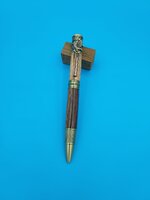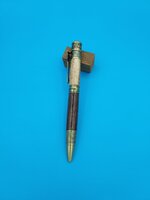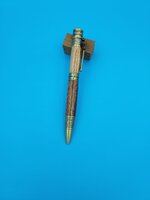wolf creek knives
Member
This is an American Patriot pen I finished for a donation to the Rocky Mountain Elk Foundation Veterans drawing for the upcoming banquet. This will accompany the knife I recently posted on this site. The lower barrel is Walnut and the upper barrel is Service-berry (stabilized) I harvested from my cabin up in the Rocky Mountains.
As you're probably all aware, Walnut can be quite riddled with fissures and grooves that normal finishes don't cover. I know many of you use CA or products similar to CA to finish your pens and get some great finishes. Me and CA don't get along and I can't use it so I rely on WOP to do my finishing. When I sanded the blanks down with up to 800 grit sand paper, the surface of the Walnut looked like the surface of the moon. Got me to thinking how I could fill in some of the craters without a lot of expense. I also didn't have time to stabilize the blanks that I'm sure would have filled in some of the voids. Here's my process.
Day 1. Cut the blanks to length, drill the tube holes and glue the tubes in with Epoxy.
Day 2. Square the blanks, remove any Epoxy inside the tube, turn to desired design, sand with up to 800 grit paper and final step was the first application of WOP.
Day 3. On the lathe sand down the blanks with 1500 grit just enough to remove the sheen of the WOP off. Clean with air and apply another coat of WOP.
Day 4-14. Do the same as day 3
Day 15. Same as day 3 but put your final application of WOP on the blanks.
Day 16. Remove the blanks from the bushings, use 800 grit paper to smooth the holes in the blanks and press the pen together.
One note, be sure to remove the bushings from the tubes after each application of WOP. Otherwise they will stick together. This is also the abbreviated version of what I did but it worked and on the photo you'll just see some texture on the Walnut blank.
The pen photo is how it turned out and the finish is just WOP, nothing else. I won't do this again but it was fun watching the craters fill in and at the same time maintain the shine without little pockets of white from sanding off the WOP.
Thanks for looking
As you're probably all aware, Walnut can be quite riddled with fissures and grooves that normal finishes don't cover. I know many of you use CA or products similar to CA to finish your pens and get some great finishes. Me and CA don't get along and I can't use it so I rely on WOP to do my finishing. When I sanded the blanks down with up to 800 grit sand paper, the surface of the Walnut looked like the surface of the moon. Got me to thinking how I could fill in some of the craters without a lot of expense. I also didn't have time to stabilize the blanks that I'm sure would have filled in some of the voids. Here's my process.
Day 1. Cut the blanks to length, drill the tube holes and glue the tubes in with Epoxy.
Day 2. Square the blanks, remove any Epoxy inside the tube, turn to desired design, sand with up to 800 grit paper and final step was the first application of WOP.
Day 3. On the lathe sand down the blanks with 1500 grit just enough to remove the sheen of the WOP off. Clean with air and apply another coat of WOP.
Day 4-14. Do the same as day 3
Day 15. Same as day 3 but put your final application of WOP on the blanks.
Day 16. Remove the blanks from the bushings, use 800 grit paper to smooth the holes in the blanks and press the pen together.
One note, be sure to remove the bushings from the tubes after each application of WOP. Otherwise they will stick together. This is also the abbreviated version of what I did but it worked and on the photo you'll just see some texture on the Walnut blank.
The pen photo is how it turned out and the finish is just WOP, nothing else. I won't do this again but it was fun watching the craters fill in and at the same time maintain the shine without little pockets of white from sanding off the WOP.
Thanks for looking



